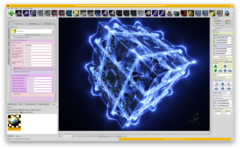Almond Bulber
| Almond Bulber
|
|
|---|---|
 Graphical user interface of mandelbulber 2.19. |
|
| Basic data
|
|
| Maintainer | Krzysztof Marczak |
| developer | The Almond Bulber Team |
| Publishing year | 2010 |
| Current version |
2.22 ( July 6, 2020 ) |
| operating system |
Windows 7 SP1 and higher, MacOS, Linux |
| programming language | Qt |
| category | Fractal generator |
| License | GNU General Public License version 3.0 (GPLv3) |
| German speaking | Yes |
| www.sourceforge.net/projects/mandelbulber | |
Mandelbulber is a fractal generating program under the GNU GPL Version 3.0 license. The program specializes in three-dimensional fractals such as Mandelbulb, Mandelbox or IFS , but fractals of other dimensions can also be visualized and rendered. Almond Bulber has been in development since 2010 and is available as a free download .
Emergence
The program appeared shortly after the well-known 3D fractals Mandelbulb and Mandelbox could be represented by fractal formulas. The name and logo are based on one of the first popular 3D fractals - the almond bulb. So the name expresses a means of creating the fractal.
Functionality
A technique called raymarching is used to render the fractals. Since this technique only saves the image and depth information, the results are not compatible with 3D mesh-based programs (such as Blender ). In addition to setting the material ( appearance , physical properties such as reflection , transparency, etc.), settings relating to rendering (accuracy, scope of rendering, error correction measures, etc.) or image resolution can be configured as desired. As a selection for rendering, the user receives a list of fractals and fractal parameters, each of which can be combined with other fractals to form so-called "fractal hybrids". Quality features such as Screen Space Ambient Occlusion (SSAO), depth of field (DOF), field of view (FOV), HDR (Blur) and others can also be set and varied. By means of already defined values for the parameters, series of images can also be generated that simulate a change in a fractal or a kind of flight through an object.
The user navigates through a Cartesian coordinate system with a camera view that shows the fractal defined by previous settings . The camera parameters are changed, for example, by clicking a point on an object or by changing the respective position. This is done by simply entering values or buttons that adjust the orientation or camera rotation.
export
There are several ways to export works within the program. This is done on the one hand as a 2-dimensional image in the formats JPG , PNG , EXR and TIFF in various bit depths . In addition, alpha channels , gloss , Z-buffer and other views can be saved separately. It is also possible to export 3D network models, for example as a voxel layering , in which, like a CT, a certain number of images is saved that can be stacked to form an object. A 3D object can be saved directly as a mesh in a PLY file . This file types specialized programs they can finalize and example as SLT file under CC - Licenses post or with a 3D printer to print. Compositions or constellations can be saved as FRACT files in a particularly resource-efficient manner by listing all parameters with names that deviate from the standard configuration. These can be included in the program or read out with a text editor . An animation can result from a series of images. These images can either be generated in a flight, which the user specifies during rendering, or the rendering process can be specified using keyframes before rendering. This sequence of images can be combined into a video with a program such as VirtualDub and published or further processed.
Technical requirements
The generation of three-dimensional objects with a fractal surface is fundamentally (very) time-consuming from a computational theoretical point of view. Peripherals such as graphics cards and sufficient RAM are recommended . While high-performance graphics cards via OpenCL need images at UHD-2 level in a few seconds, processors that are several years old or non-specialized CPUs can take 20 minutes or more. In addition, RAM memory in the double-digit gigabyte range is necessary so that there is enough intermediate memory for the program. If the equipment is insufficient, rendering can also be performed on the server . An ultra-high resolution video cannot yet be rendered in real time with today's PC technology (as of July 2019).
Review and criticism
The reviews are very positive. Above all, the opportunities for discovery that this program offers are praised. However, issues related to rendering bugs are also addressed. Bug fixes appear regularly at 3 to 6 month intervals.
Web links
Individual evidence
- ^ Krzysztof Marczak. In: GitHub . Retrieved July 21, 2019 .
- ↑ License. In: sourceforge.net. Retrieved July 21, 2019 .
- ↑ https://sourceforge.net/projects/mandelbulber/
- ↑ End User Manual
- ↑ https://sourceforge.net/projects/mandelbulber/
- ↑ https://sourceforge.net/projects/mandelbulber/files/Mandelbulber%20v2/win64%20build/
